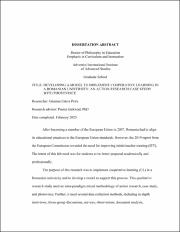| dc.description.abstract | After becoming a member of the European Union in 2007, Romania had to align
its educational practices to the European Union standards. However, the 2019 report from
the European Commission revealed the need for improving initial teacher training (ITT).
The intent of this felt need was for students to be better prepared academically and
professionally.
The purpose of this research was to implement cooperative learning (CL) in a
Romanian university and to develop a model to support this process. This qualitative
research study used an intra-paradigm mixed methodology of action research, case study,
and photovoice. Further, it used several data collection methods, including in-depth
interviews, focus-group discussions, surveys, observations, document analysis,
photovoice, analytic memos, written communication, and research literature. The study
explored the process of implementing CL in the selected university, in two cycles of
action research. The first cycle took place in 2018, and the second cycle in 2019.
The process of CL implementation followed a three-step model: planning,
performing, and perfecting. The participants were faculty, students, and experts, selected
by using purposive criterion sampling. The data were analyzed by using the
HyperResearch software. From the analysis, 11 themes, 34 categories, and 16
subcategories emerged. The findings showed that CL was perceived as effective for the
ITT program, both academically and professionally. The findings also bound together
seven core components for CL implementation: (a) training model, (b) flipped classroom,
(c) classroom management, (d) dimensions of learning, (e) interactive lecturing,
(f) mastery learning, and (g) integration of faith and learning. The developed process
model was named CoLearnITT—cooperative learning for initial teacher training. The
findings resulted in recommendations for (a) administrators—they could organize
trainings in CL for their faculty; (b) teachers—they are encouraged to implement CL in
their classes; and (c) students—they could adopt the CoLearnITT model for their future
profession. This model is a flexible guide for faculty and students interested in improving
teaching and learning through CL. | en_US |

